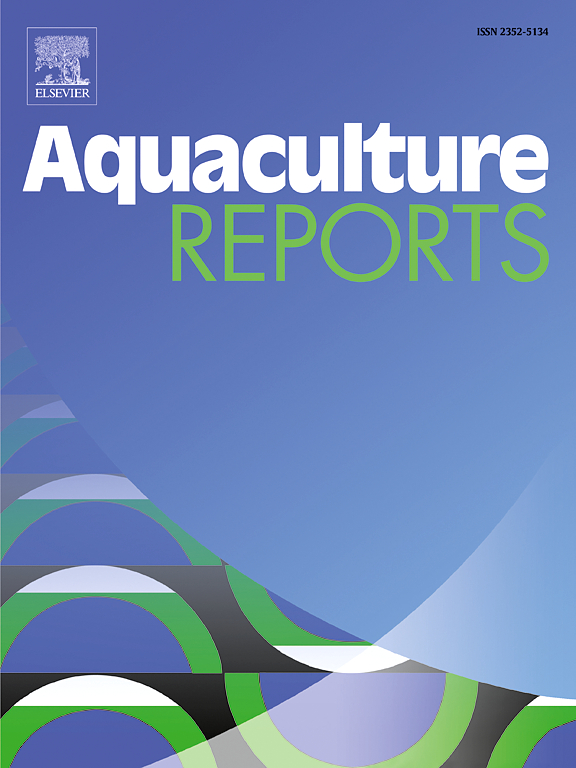多波长紫外线辐射对循环水系统中大肠杆菌灭活和再活的影响
IF 3.2
2区 农林科学
Q1 FISHERIES
引用次数: 0
摘要
紫外线消毒在控制水产养殖大规模暴发疾病中起着至关重要的作用。紫外发光二极管(UV-LED)是一种安全高效的新型光源,可以组合特定波长。本文研究了UVC-LED(275 nm)和UVA-LED(365 nm)对大肠杆菌(E. coli)的清除和再活化的影响。结果表明,UVC-LED能有效灭活大肠杆菌,而UVA-LED对大肠杆菌的去除效果有限。随着UVC-LED剂量的增加,细菌的失活程度增加。在联合处理中,UVA-LED预处理提高了大肠杆菌的去除率。UVA-LED联合照射后UVC-LED照射表现出协同效应。3240 mJ/cm2的UVA照射后,750 mJ/cm2的UVC照射导致3.18 log失活,比单独750 mJ/cm2的UVC照射高约2 log。消毒后,大肠杆菌表现出再活化,暗修复率超过光活化率。随着UVC照射时间的延长,细菌的再激活率增加。高剂量连续UVA-UVC照射可有效抑制细菌再活化,延缓细菌再活化。UVA照射3240 mJ/cm2, UVC照射750 mJ/cm2后,大肠杆菌的暗修复率在72 h时最低达到193.81 ± 5.85 %。本研究揭示了UVA-LED和UVC-LED联合使用对细菌的有效灭活,阐明了紫外线协同消毒过程中灭活和再活的作用机制和影响因素。更逼真地模拟实际水处理过程。高剂量紫外线照射和照射后避免可见光可有效抑制细菌的再活化。我们的研究结果为循环水养殖中紫外线消毒的设计和操作提供了有价值的见解,也清楚地展示了实际水处理过程中的挑战。本文章由计算机程序翻译,如有差异,请以英文原文为准。
Effects of multi-wavelength ultraviolet radiation on the inactivation and reactivation of Escherichia coli in recirculating water system
Ultraviolet (UV) disinfection plays a crucial role in controlling large-scale outbreaks disease in aquaculture. As a safe and efficient new light source, ultraviolet light-emitting diode (UV-LED) can combine specific wavelengths. The effects of the combination of UVC-LED (275 nm) and UVA-LED (365 nm) on the elimination and reactivation of Escherichia coli (E. coli) were investigated in this study. The results showed that UVC-LED could effectively inactivate E. coli, while UVA-LED had a limited effect E. coli removal. The inactivation of bacteria increased with the UVC-LED dose. It was found that UVA-LED pre-treatment improved the removal of E. coli in the combined treatment. The combination of UVA-LED followed by UVC-LED irradiation exhibited a synergistic effect. UVA irradiation at 3240 mJ/cm2 followed by 750 mJ/cm2 UVC irradiation resulted in a 3.18 log inactivation, which was about 2 log higher than that achieved by 750 mJ/cm2 UVC irradiation alone. Following disinfection, E. coli exhibited reactivation, with the dark repair rate exceeding that of photoreactivation. The bacterial reactivation rate increased with duration after UVC irradiation. High dose sequential UVA-UVC irradiation can effectively inhibit bacterial reactivation, delaying the reactivation. After 3240 mJ/cm2 UVA followed by 750 mJ/cm2 UVC irradiation, the dark repair rate of E. coli reached a minimum of 193.81 ± 5.85 % at 72 h. This study revealed the effective inactivation of bacteria through the combination of UVA-LED and UVC-LED, clarifying the mechanisms and influencing factors associated with inactivation and reactivation during UV synergistic disinfection. Simulate the actual water treatment process more realistically. And the bacterial reactivation can be effectively inhibited by high-dose UV irradiation and avoidance of visible light after irradiation. Our findings provide valuable insights for the design and operation of UV disinfection in recirculating aquaculture, it also clearly presenting the challenges in the actual water treatment process.
求助全文
通过发布文献求助,成功后即可免费获取论文全文。
去求助
来源期刊

Aquaculture Reports
Agricultural and Biological Sciences-Animal Science and Zoology
CiteScore
5.90
自引率
8.10%
发文量
469
审稿时长
77 days
期刊介绍:
Aquaculture Reports will publish original research papers and reviews documenting outstanding science with a regional context and focus, answering the need for high quality information on novel species, systems and regions in emerging areas of aquaculture research and development, such as integrated multi-trophic aquaculture, urban aquaculture, ornamental, unfed aquaculture, offshore aquaculture and others. Papers having industry research as priority and encompassing product development research or current industry practice are encouraged.
 求助内容:
求助内容: 应助结果提醒方式:
应助结果提醒方式:


